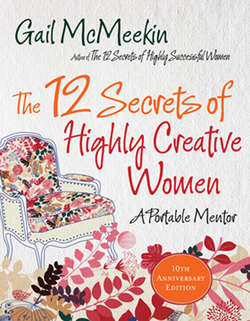Читать книгу The 12 Secrets of Highly Creative Women - Gail McMeekin - Страница 16
На сайте Литреса книга снята с продажи.
Practicing Play
ОглавлениеIn addition to receptivity and time, we must also grant ourselves the freedom to play creatively. Painter Michelle Cassou, founder of an original approach to creative painting described in her book, Life, Paint, and Passion, and cofounder of The Painting Experience Studio in San Francisco, urges aspiring creatives to “recover the capacity to invent that you had as a child.” In fact, as a young Frenchwoman, Michelle searched unsuccessfully for the right art school and was even advised to give up painting. Luckily, at the age of nineteen, she discovered the Free Expression School in Paris for children ages five to fourteen and wept with delight. Forsaking traditional art school, Michelle simply painted with the children for three and a half years, basking in their freedom and lack of judgment. As a result, she unlocked her own creative potential. Today, her collection of paintings is breathtaking, and she continues to paint prolifically. When she moved to America, she opened the Painting Experience, workshops where she offers the richness of uncensored expression to all participants. Had Michelle ignored her attraction for painting and had she not surmounted the obstacles in her path, including the academics telling her to quit, she would have forsaken her true work and her inner self.
We owe most of our great inventions and most of the achievements of genius to idleness—either enforced or voluntary.
—AGATHA CHRISTIE, MYSTERY WRITER
For June Levinson, bliss is getting down and dirty with her beloved clay. For years as an art dealer and more recently as owner of the Levinson Kane Gallery on Boston's famed Newbury Street, June succeeded at the business of art. She became a dealer because she wanted to collect art and didn't have enough confidence in her talent as a painter. But ultimately she couldn't hold back the artistic sense within her. After closing her gallery, she began beading, making necklaces and other jewelry, easily selling them to friends despite her determination to keep her art fun and not turn it into a business. She then discovered that she loved making the beads herself, which led her to the wonderland of ceramics.
June has been both a friend and a fellow explorer of creativity. She has a daring about her as well as a grounded practicality that is refreshing.
I'm still fascinated by the surprise of images. . . .
—ANNIE LEIBOVITZ, PHOTOGRAPHER
These days she is luxuriating in the opportunity to study ceramics at the Radcliffe College Ceramics Studio, meet interesting people, and express the artist within her, instead of promoting the artwork of others. Without all her previous responsibilities, June delights in being a beginner, “I have a lower standard for myself in ceramics than I did as a painter when I compared myself unfavorably to great artists like Robert Motherwell. When I made my first bowl, it was cockeyed and off center, but I was so excited. I brought it home and said to myself, ‘The popcorn won't mind.’ I use it all the time. I'm more forgiving of my results now. How censorious can you be about a bowl? On the other hand, I look at it and say there's all the wonder in the world in a little bowl.” June's utter joy in the process has unlocked a whole new focus for her life. Like her grandchildren, with whom she takes exciting adventures, June's playful jubilation with ceramics has reconnected her with her own childlike wonder.
